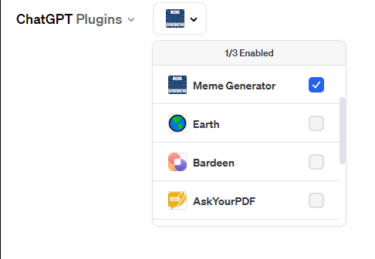ChatGPT Guide: Use these prompt strategies to maximize your results

Update –
- Article fundamentally restructured and expanded.
- Information on models and functions updated.
What is the best way to interact with ChatGPT? There is virtually no right or wrong way to interact with the AI. However, there are some guidelines to help formulate the right prompts.
ChatGPT has been available since the end of November 2022, and users have been exploring the limits and possibilities of the chatbot ever since. But OpenAI is also constantly making adjustments.
To achieve the desired result, you need prompts that are as concrete as possible. In addition to simple text generation for blog or social media posts, ChatGPT is capable of much more diverse, sometimes curious, use cases.
While there are many tips and suggestions for ChatGPT commands floating around the web, we want to share a few selected and reviewed ones that we find particularly helpful.
Basic tips
Interface
- By default, every free chat starts with the fastest GPT-3.5 model. With an active Plus membership, GPT-4 runs automatically with a current limit of 40 messages per three hours. Image generation with DALL-E 3, Bing searches and the Code Interpreter (or Advanced Data Analysis) are automatically turned on when ChatGPT recognises that they are needed for the prompt.
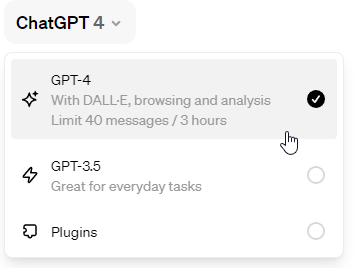
- Plugins may need to be enabled in the Preferences. The "Plugins" option will then be available in the model selection alongside GPT-4 and GPT-3.5. These are third party content that must first be installed from the rudimentary "Plugin Store". Up to three plug-ins can be activated at the same time.
- ChatGPT processes up to 32,000 tokens in one input with GPT-4 Turbo. If the input is too long, an error message will be displayed. A token is approximately one word, depending on the application. GPT-3.5 Turbo, the model available to free users of ChatGPT, has a context window of 16,385 tokens.

- The generation of responses can be stopped with the stop button above the input field.
- After a response has been generated, it can be re-generated by clicking the "Regenerate response" button, which may result in a different response.

- If too much knowledge has been exchanged in a chat, it may be helpful to start a new chat to avoid distorting the subsequent answers.
- At least so far, ChatGPT's interface doesn't allow you to bookmark certain chats to quickly return to them. There is, however, a small workaround: Chats can now be shared with other users via a link. This link can then be added to your own list to save it.
- The link can also be used in GPT-4 with browsing mode to retrieve information from an older chat in a new chat.
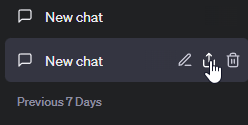
- Chats can only be deleted one at a time, not several at once. However, there is a way to delete all previous conversations from the context menu after clicking on the profile in the lower left corner. But be careful: This step cannot be undone.
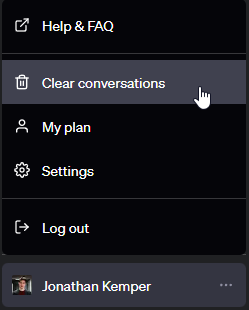
- By default, OpenAI uses all user-entered data to train its models. If you do not want this, you can turn off data processing in the settings. However, this also means that chats will not be saved for later use.
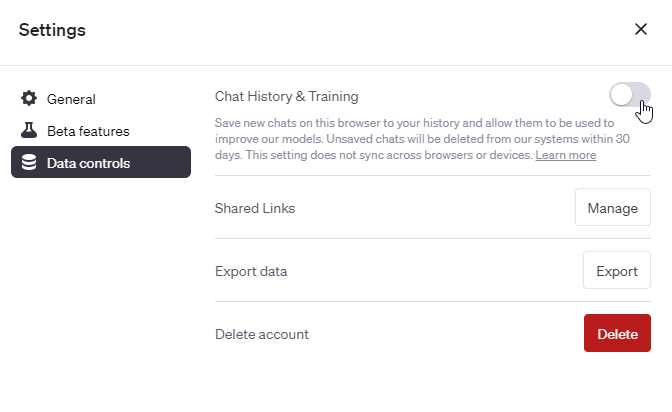
How to write
- ChatGPT was trained on multilingual data, but the proportion of English text in the training material is significantly higher. It may help to perform queries in English and only translate the output afterwards using tools like DeepL.
- You should give voice AIs like ChatGPT as clear instructions as possible. This also means that it is best to use strong, expressive verbs. For example, instead of "rewrite the text", "clarify the text" may give a better result.
- Also, use positive rather than negative phrases, e.g. "write formally" rather than "do not write informally".
- Separators such as triple quotes (""" """), XML tags (<tag> </tag>), or section headings can help the AI separate sections of text that should be treated differently.
- ChatGPT cannot count exactly, but will usually roughly follow any word or character limits given in the prompt. GPT-4 is better at counting than GPT-3.5.
- After a successful conversation, it helps to ask ChatGPT for a summary ("Write a summary of our chat so far.").
What is the difference between GPT 3.5 and GPT 4?
If you have a subscription to ChatGPT Plus, you have access to the newer GPT-4 language model in addition to GPT-3.5. But what are the differences and which one should you use in which application?
Data quality
While both models were developed by OpenAI and are designed to produce human-like text, GPT-4 has been trained on a larger amount of data and with a greater number of parameters, resulting in overall improved accuracy and text quality.
Context window
The amount of text that the models can consider in a prompt is another major difference. While GPT-3.5 understands up to 16,385 tokens, the version of GPT-4 Turbo integrated in ChatGPT can handle up to 32,000. On average, a token is about 0.75 words.
File Upload
Only with GPT-4 can files and images be uploaded and accepted by the language model in addition to text prompts. Images are processed by the GPT-4V vision model.
Additional functions
In addition, GPT-4 can be combined with features such as DALL-E 3, the code interpreter and plug-ins, which greatly expands the possible applications. The use of GPT-4 is currently limited to 40 messages within three hours, despite the paid Plus membership. After that, the conversation can be continued with GPT-3.5.
What are GPTs ("Explore")?
Behind the "Explore" button in the top left corner of the ChatGPT website interface are the so-called GPTs, which OpenAI announced at the Dev Days in November 2023. The GPTs are the evolution of the plugins, but are currently being developed in parallel. In the long term, a marketplace for GPTs is planned, similar to the plugin store, so that you can easily access customised chatbots from other users, and providers of particularly successful GPTs can even share in ChatGPT's revenues.
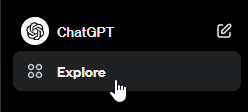
The Explore interface currently only gives you access to GPTs created by OpenAI itself, such as those optimised for cooking recipes, maths tutorials or washing instructions for clothes. You can also create your own chatbot and give it a system prompt, additional files and API access.
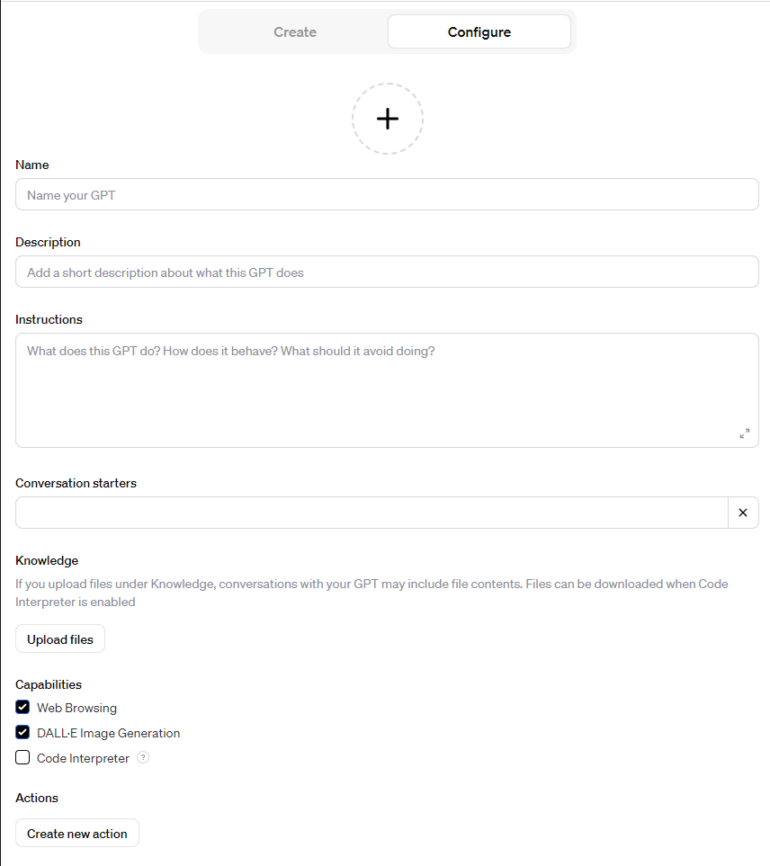
What are the benefits of the ChatGPT app for smartphones?
In addition to the web interface at chat.openai.com, ChatGPT is also available as an app of the same name for Android and iOS. This comes with some practical additional functions. As in the browser, you can upload images, but you can also use the touchscreen to mark special focus areas for the AI to concentrate on.
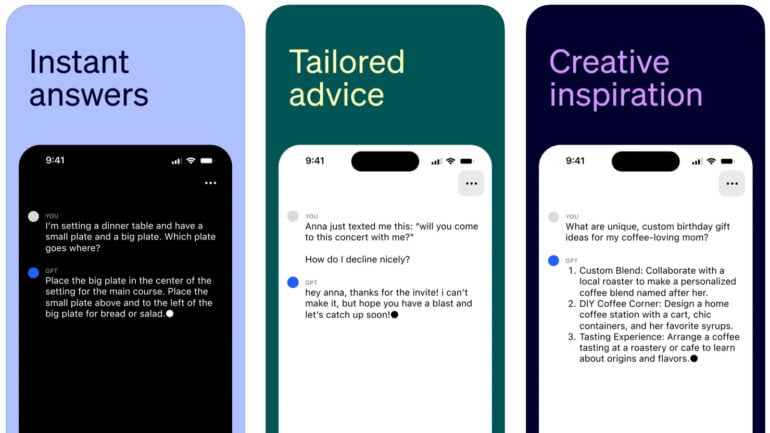
In addition, prompts can be spoken thanks to OpenAI's very powerful Whisper speech recognition. Answers can then be read back by OpenAI's own text-to-speech models, creating a more natural interaction with the AI tool.
Are GPT-4 and DALL-E 3 also available free of charge?
Although OpenAI charges for ChatGPT with GPT-4 and the DALL-E 3 image generator, there are free ways to get a similar user experience - and it is completely legal! Thanks to the collaboration between Microsoft and OpenAI, the most powerful GPT models, including DALL-E 3, are included in Bing and the Copilot app for smartphones.
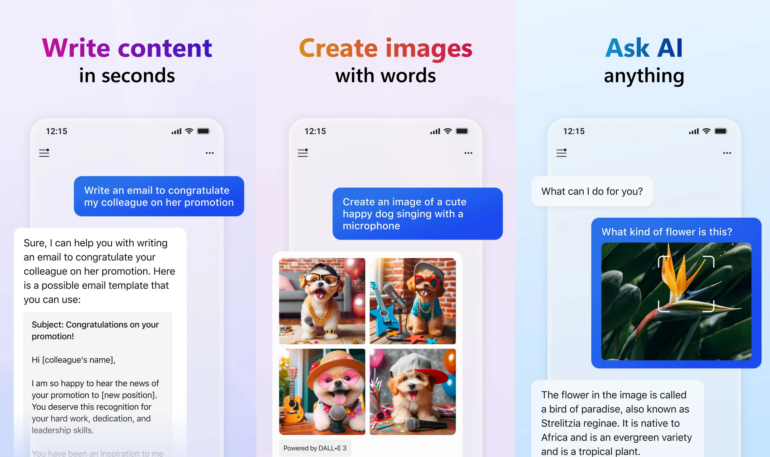
General prompt examples
Prompting for ChatGPT and other tools that use large language models is always structured in a similar way. Thus, phrase-based prompts work not only with GPT-3.5 and GPT-4, but also with other commercial services such as Bard or Claude, or with open-source models.
Important components
There is no "right" or "wrong" way to write a prompt. However, there are several components that make up a good prompt. Before we go into more detail in the rest of this guide and present sample prompts, here is a compact overview of what a prompt can or should consist of:
Defining the role that ChatGPT will play
Defining the address and channel
Specifying a sample response
Specifying the output format
Although OpenAI had previously presented various prompt elements in its help section, in December 2023 the company followed up with six specific strategies for writing a prompt.
Set role
Linux terminal, philosopher, tea taster or Bible translator - ChatGPT can play all these roles and more. All the AI needs is a nudge in the right direction.
Conveniently, developer Fatih Kadir Akın has compiled a whole series of such situation descriptions, including formulated prompts, on his website.
The prompts always have the same structure: First, ChatGPT receives a prompt telling it what role the AI should play. Then the prompt tells the AI what information the user has provided, followed by what the AI is supposed to do with it, including rough suggestions for direction. Finally, the developer puts the first concrete instruction in quotation marks.
Example travel guide
I want you to act as a tour guide. I'll write you my location, and you'll suggest a place for me to visit near my location. In some cases, I will also tell you the type of places I will visit. You will also suggest places of a similar nature that are near my first location. My first command is "I am in Istanbul/Beyoğlu and I just want to visit museums."
Define address and channel
It is advisable to give ChatGPT as much information as possible to avoid tedious rewriting, either manually or through another prompt. You should clarify for the AI how you want the reader to be addressed and what channel the text is intended for.
It makes a big difference to ChatGPT whether the text is output as a blog post, a store page, a LinkedIn post, a tweet, a TikTok, or a YouTube script. ChatGPT also handles gender, as long as you specify the desired form at the beginning.
Example TikTok
I need a script for a TikTok about the opportunities and risks of ChatGPT. Use as short sentences as possible. Address the viewer as you. Use gender-neutral language if possible.
Give an example answer (one-shot prompting)
The less effort you put into formulating the prompt for ChatGPT, the less effort the AI seems to put into it. Such open-ended "zero-shot prompts" often produce unsatisfactory results because the AI has to make too many decisions on its own.
The goal can be achieved by providing a structure with sample content (or template) for an answer in the request, which ChatGPT will then follow. This strategy is also called "one-shot prompt".
Example One-shot prompt
Describe the bird species using the following format:
Name: golden eagle
Wingspan: average 200 to 220 cm, can reach 260 cm.
Diet: Golden eagles are birds of prey and feed on a variety of animals, such as groundhogs, hares, foxes, and deer. Other birds are also part of their diet, such as pheasants, capercaillies and even other birds of prey.
Habitat: Golden eagles are at home in the mountains and live in rocky regions and mountains. They are found in Europe, Asia and North America.
Natural enemies: Because of their size and strength, golden eagles usually have no natural enemies. However, they can be attacked by wolves, bears or lynx, especially when they are still young.
Name: Mallard
[Output]Name: Parrot
[Output]Name: Hummingbird
[Output]Name: etc. ...
[Output]
Providing multiple responses (few-shot prompting)
Few-shot prompting is an evolution of the one-shot technique. As the name suggests, it provides several sample answers instead of just one. This gives the AI a more accurate picture of the formatting and content of the text.
Example Few-shot prompt
Describe bird species in the following formatting:
Name: golden eagle
Wingspan: average 200 to 220 cm, can reach 260 cm.
Diet: Golden eagles are birds of prey and feed on a variety of animals, such as groundhogs, hares, foxes, and deer. Other birds are also part of their diet, such as pheasants, capercaillies and even other birds of prey.
Habitat: Golden eagles are at home in the mountains and live in rocky regions and mountains. They are found in Europe, Asia and North America.
Natural enemies: Because of their size and strength, golden eagles usually have no natural enemies. However, they can be attacked by wolves, bears or lynx, especially when they are still young.Name: Mallard
Wingspan: 81 to 98 cm on average.
Diet: Mallards are omnivores and feed on a wide variety of plants and small animals. Their diet consists mainly of aquatic plants, insects, small fish, snails and crustaceans.
Habitat: Mallards are found in many parts of the world and live in a variety of freshwater habitats including lakes, ponds, rivers and marshes. They are the most common and best known wild duck in Europe and North America.
Natural enemies: The mallard's natural enemies are various birds of prey, foxes, weasels and large fish. Humans can also pose a threat through hunting and habitat destruction.Name: Parrot
Wingspan: Varies from 20 to 120 cm depending on the species.
Diet: Parrots are mainly herbivores, eating fruits, seeds, nuts, flowers and occasionally insects and other small animals.
Habitat: Parrots live in different regions of the world, mainly in tropical and subtropical areas. They can be found in Central and South America, Australia, Africa and Asia.
Natural enemies: Natural enemies of parrots include birds of prey, snakes, monkeys and large cats of prey. However, the greatest threat to many parrot species is man, as habitat destruction and the illegal trade in exotic birds have brought some species to the brink of extinction.Name: Kolibri
[Output]Name: etc. ...
[Output]
Chained Prompting
A keyword often mentioned by experts in connection with better ChatGPT input is "chained prompting". This involves breaking down complex tasks into multiple intermediate steps in the hope that the AI will deliver a more concrete, customized, and thus overall better result. This works in a single long prompt as well as in several in a row.
Probably the simplest form of chain prompting is to first ask for the structure of an article. Then you can ask ChatGPT to formulate the corresponding bullet points.
This method also saves time: If you notice that the AI is going down the wrong path during the outline, you can make the necessary adjustments before the full text is generated.
Example Chained Prompting
Write an article about ChatGPT. First give me the outline, which consists of a headline, a teaser and several subheadings. [Output] Now write five key messages for each subheading. [Output] Add five keywords to the key messages for each subheading. [Output] And so on ...
Modify output
Even if you have followed all the previous advice, you may want to prepare the same content for different channels, such as LinkedIn, Twitter, or Facebook. The text should be adapted to the tone and formatting of the target channel.
Again, ChatGPT takes care of this task with the right command. Important arguments can be the mention of the channel, but also descriptions of the format.
Example Twitter
Formulate the generated text in several tweets. Note the maximum length of 280 characters per tweet. Use short sentences and do not stretch them over several tweets. Start the tweets with a consistent numbering.Example LinkedIn
Formulate the generated text as a LinkedIn post. Note the maximum length of 3000 characters. Structure the core statements of the text as a clear list. Get started with an exciting teaser sentence and end the post with a call to action for comments, shares or likes.
Format output
By default, ChatGPT responds verbosely in plain text. However, the AI tool actually handles formatting in the Markdown markup language, such as headings, bold or italic text, ordered (numbered) or unordered lists, and even tables.
You can use these features in your text generation. In most cases, however, ChatGPT does not come up with the idea itself and therefore needs a suitable formatting hint. Of course, you can format afterwards using chained prompting.
Example Markdown
I want to have a blog article written about ChatGPT. Write a headline, a teaser, a subtitle and a paragraph. Format everything in markdown.
Special prompt examples for ChatGPT
Using the GUIDE technique
The GUIDE technique is a helpful approach for considering all the necessary components of a prompt. The goal, user, instructions, details and examples are clearly defined.
Example of a GUIDE prompt
Goal: Create a healthy weekend meal for dinner.
User: Busy parents looking for quick, nutritious meals.
Instructions: Create a recipe for a 30-minute meal using simple ingredients that most people have on hand.
Details: The dish should contain lean protein, vegetables and some whole grains. It should be around 500 calories per serving and low in saturated fat and sodium.
Example: Follow recipes from websites such as Chefkoch or Einfach Kochen.
Generate prompt guide
Justin Fineberg came up with an interesting way to communicate with ChatGPT. Similar to the first tip above, the AI is instructed to take on a specific role. This time, however, ChatGPT takes over the tedious task of generating the structure for further prompts.
In other words, the chatbot will ask itself the exact questions it needs to answer in the next prompts. If ChatGPT writes the questions in the form of a numbered list, you can refer directly to the numbers.
Example prompt instruction
You are a robot for creating prompts. You need to gather information about the user's goals, examples of preferred output, and any other relevant contextual information. The prompt should contain all the necessary information provided to you.
Ask the user more questions until you are sure you can create an optimal prompt. Your answer should be clearly formatted and optimized for ChatGPT interactions. Start by asking the user about their goals, desired outcome, and any additional information you may need.
Interview a panel of experts
Following the general tip of assigning a specific role to ChatGPT, you can also get the opinions of various experts with just a few prompts.
As a first step, the AI will help you make a list of the experts you require. It will then run a role play in which each of the fictional people gives a tip.
Example interview a panel of experts
I want to start a business. What kind of experts could best help me with this?
[Output]
Play a role-playing game in which each of the experts gives me advice on what to do.
Let people practice self-criticism
ChatGPT is already a useful tool for critiquing text written by humans, so why not apply this tactic to text written by AI?
In line with this idea is the following strategy, which is divided into two steps (see "Chained Prompting"): First, ChatGPT should convincingly dissect the text piece by piece. Then, in a second prompt, get the AI to rewrite the text based on those very criticisms.
Example self-criticism
Critique the following text and convince me why it is not good. Let's think about the problems of the text step by step.
[First Output]
Good points. Rewrite the text and improve it based on your criticism.
[Output]
Use the SCAMPER method
The SCAMPER method is a creative thinking tool that offers seven different techniques for solving problems and generating ideas: Substitute, Combine, Adapt, Modify, Repurpose, Eliminate, and Reverse.
Original prompt
Write a short story about a spaceship.Substitute
Write a short story about a submarine.Combine
Write a short story about a spaceship and a lost civilization.Adapt
Write a short story about a spaceship trapped in a black hole.Modify
Write a short story about a spaceship controlled by an artificial intelligence system.Put to another use
Write a short story about an old spaceship being used as a museum.Eliminate
Write a short story about a ship.Reverse
Write a short story about an alien civilization that discovers a human spaceship.
Use ChatGPT with other tools
Visualize mind maps
A major advantage of ChatGPT over GPT-3 is that the user interface inherently supports output in Markdown format. This allows for quick visual differentiation between different hierarchies of headings, which is very helpful when visually structuring a text.
Markdown texts can be converted into mind maps via the free website markmap.js.org, as Alexander Leirvåg writes on Twitter. Based on the hierarchy of the respective headings, the website displays the entered text as a mind map and even supports further formatting of the individual entries, e.g. for code or formulas.
The graphic can then be downloaded either as an interactive web page in HTML or as a vector graphic in SVG format.
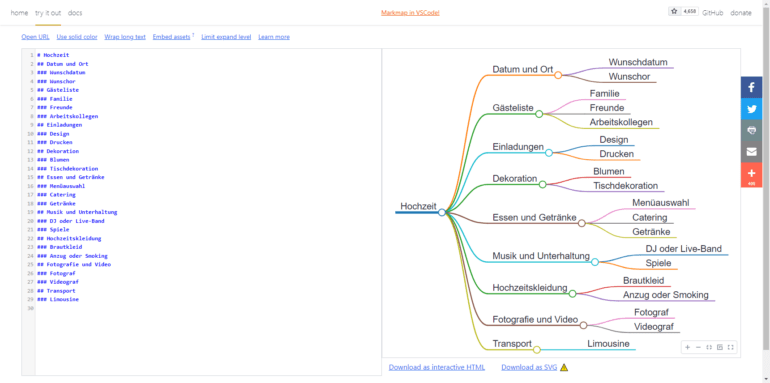
Important: To properly copy text that is formatted as markup, you must prevent ChatGPT from displaying it as markup. This can be done by telling the AI to include the output of ``, which means Markdown formatting for code.
Example mindmap
Markmap syntaxIn markmap, each layer becomes a separate branch by #.Example: mindmapping a birthday party.# Birthday## Activities### Fishing Candy### Trampoline## Food### Cake### Hotdogs...Use Markdown to create a mindmap for planning a wedding. Enclose the output in ` and `.
If you like it a bit more complex, you should familiarize yourself with the syntax of Mermaid. You can simply give ChatGPT an example to follow. Mermaid diagrams are more visually appealing than simple mind maps and can even be provided with icons that ChatGPT selects itself.
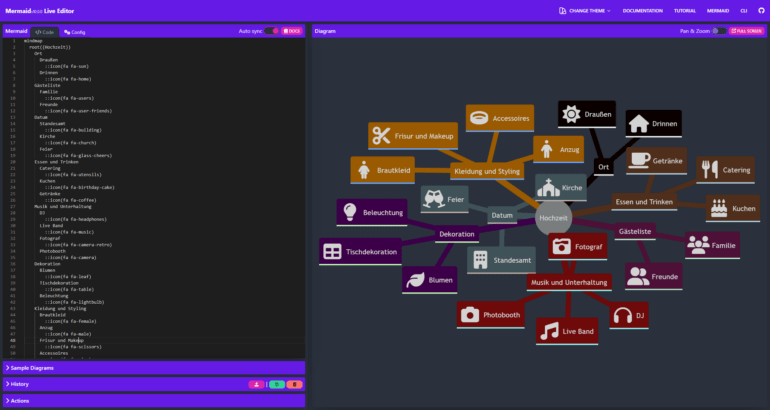
Mermaid cannot handle hyphens in node labels (e.g. "make-up"). These must be removed from the ChatGPT output. You can paste the output of ChatGPT into mermaid.live to convert it to a graphic.
Example Mermaid
Create the code for a mindmap in Mermaid for planning a wedding, using appropriate icons. Make sure you have the right number of spaces for the hierarchy of layers. Enclose the output in ` and `.Here is an example of code for Mermaid:mindmaproot((Wedding))VenueOutdoor::icon(fa-sun)Indoor::icon(fa-home)Guest ListFamily::icon(fa fa-users)Friends::icon(fa-user-friends)
What ChatGPT cannot do
Despite all its possibilities, ChatGPT - regardless of the model chosen, such as GPT-3.5 or GPT-4 - has some clearly defined limitations. These can sometimes be circumvented by specially written commands (so-called jailbreaks). As a rule, however, ChatGPT will quickly make it clear which commands it does not want to follow.
For example, the chatbot is (usually) unable to give advice that involves criminal intent, such as robbing a bank, building a bomb or programming malware. In the meantime, a scene has emerged on the darknet that manipulates language models for precisely these use cases.
Even if the request is not necessarily criminal, but at least offensive or abusive, it will be rejected. Requests for personal assessments or opinions, as well as future predictions, are also generally rejected by ChatGPT.
AI News Without the Hype – Curated by Humans
As a THE DECODER subscriber, you get ad-free reading, our weekly AI newsletter, the exclusive "AI Radar" Frontier Report 6× per year, access to comments, and our complete archive.
Subscribe nowAlexander Leirvåg | Ruben Hassid | ABC | Florian Camiade | OpenAI | MakeUseOf

